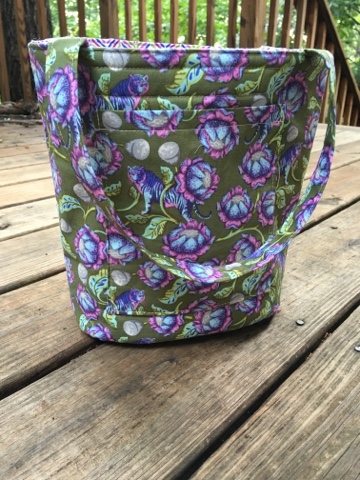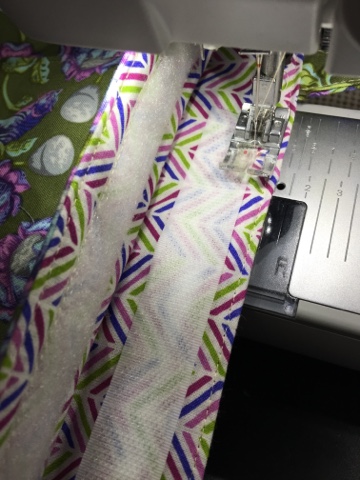It's my turn for Sew-A-Softie Day! Thanks to Trixi of
Coloured Buttons for organizing a world-wide "day" of sewing and teaching someone new to our world! I'm excited about my tutorial, I think you're going to love it. It's a lot easier than you might think.
Did you have a hobby horse, otherwise known as a 'stick horse', when you were a kid? I remember having the kind on springs mounted to a metal frame. If you really got rocking on it, you could almost touch the ground with your nose. I'm not sure how it never tipped over!
I suppose you can buy them new, nowadays, and I bet they've been redesigned with more safety features, and I bet a kid can no longer shorten their nose on the pavement on one. Oh well, you can make the next best thing right now! Just gather up your supplies and in a few hours, your kid will be traipsing through the wild, wild west fighting off the bad guys from horseback! Or, you'll have the prize winning baby shower or first birthday gift.
You will need:
-1/2 yard fabric
-1/2 yard medium-weight fusible interfacing
-scrap of EZ Steam II
-Scraps of felt in white, black and your choice of eye color
-1"x36" wooden dowel
-polyester fiberfill
-hot glue gun/glue sticks
-Fabric pen, marker or chalk
-1 spool or 2 yards lace, fringe, pompoms, jumbo rick-rack etc for the hair
-1 spool 1/2"-3/4" wide ribbon for reigns and harness
-1/2 yard coordinating ribbon to cover head/stick joining
-optional wooden knob or cane cap (for the end of the stick)
-optional bells, rhinestones, buttons etc for decoration
Plus the usual stuff: sewing machine, thread, scissors, optional pinking shears etc.
**Seam allowance is 1/4" unless noted otherwise**
For this tutorial, you will be creating your own pattern but don't worry. It's pretty straight-forward and you don't need anything special; just a few simple things that you have already. You will need:
-A paper grocery sack
-pencil
-ruler
-paper scissors
-a few round objects of different sizes (a dinner plate, a spice jar, a small bowl or measuring cup)
Ready to get started? Here we go...
To create the pattern, you will need to cut the bottom off the paper sack, then cut it down the back seam to open it up flat. You will only need about half of the sack, so set the other piece aside for future use.
-Starting at the bottom right side of the paper, draw a 5" line.
-On the right side of the line, draw a 14" perpendicular line up towards the top of the paper.
-On the left side, draw a 6" perpendicular line up towards the top of the paper. (This line will be parallel to the 14" line.)
-From the left side of this new line, draw a 7" line towards the left side of the paper. (This line will be parallel to the very first line, but will extend past it not over it.)
-From the left side of this line, draw a 3" perpendicular line. (This line will be parallel to the 14" line.)
-Now, connect the 3" line to the 14" line in one long 13" diagonal line.
You should have something that looks like this:
Now, pull out your round objects-probably the dinner plate-and start rounding the corners. You can do this by hand, if you prefer, but if you're nervous about it, use a plate for guidance. It should look something like this when you're done:
 |
| For the neck, the curve should connect underneath not inside. If you look closely at my photo, I did it wrong at first but then scratched it out and resketched it on the underside. |
-Starting from the bottom right of the horse head, measure up 10 5/8" and over 1 1/4"; draw
a 1 1/2" line. (This line will be parallel to the bottom 5" line.)
This is the ear placement; see photo below for details.
-Measure 4 1/2" from the upper right corner, make a mark.
-Measure 1 1/2" up from bottom right corner, make a mark.
These two marks are for hair placement.
Cut two heads from fabric, and two from interfacing.
Follow manufacturer's instructions to fuse interfacing to wrong side of fabric head.
Use a fabric marker to transfer hair placement lines on one side of the horse.
-For the ear, fold a 7" square scrap of paper in half.
-From the fold, draw a 1 1/2" perpendicular line.
-Draw a parallel line 1/2" below to mark seam allowance.
-From this line, measure up 5" on the fold and make a mark.
-Connect the two lines using the photo below as a guide.
Cut two ears from fabric, two from interfacing and two from white felt scrap.
Follow manufacturer's instructions to fuse interfacing to wrong side of fabric ears.
-For the eye, draw a 3 1/2" line on another 7" square scrap of paper.
-Using the spool of ribbon, align the curve just far enough to connect the points.
-Fold along the line, then cut out the eye pattern.
Cut two eyes from white felt and two from EZ Steam II.
Follow manufacturer's instructions to apply EZ Steam to back of eye.
-For the iris, use the small bowl, spice jar or hand draw onto a piece of paper. I used a tin teacup from my daughter's play tea set.
Cut two eyes from colored felt and two from EZ Steam II.
Follow manufacturer's instructions to apply EZ Steam to back of iris.
For the pupil, I used the iris piece to trace onto black felt and then cut it down to fit.
Cut two pupils from black felt and two from EZ Steam II.
Follow manufacturer's instructions to apply EZ Steam to back of pupil.
Now you're ready to get sewing. That's the best part! Yay!
With wrong sides together, sew one fabric ear to one felt ear; using pinking shears (optional) carefully trim the seam allowance in half. If you don't have pinking shears just use scissors.
Turn ears right side out; press. Topstitch using a 1/8" seam allowance. Measure up 1/2" from bottom of ear; draw a line.
Fold the ear in half, felt sides in. Measure over 3/8" from the fold; draw a 1/2" line (parallel to the fold). Stitch along this line, making sure to backstitch at both ends.
Place horse heads wrong sides together with the pattern laid on top. Using a rotary cutter and acrylic ruler, carefully cut along the ear placement line. If you don't have a rotary cutter and ruler, align the fabric and pattern pieces, fold along the ear placement line and draw the line directly on the fabric; cut through both layers with scissors.
Lay one head right side up, with felt side of ear down, insert ear into slit aligning the line you drew to the cut in the fabric; edge stitch in place, making sure to backstitch at both ends.
To make eyelashes, cut V notches into a 1"x 2" rectangle of double layer of felt.
Peel off paper backing from the eye, place on the head somewhere you think looks best. Starting from the outer corner of the eye, place one eyelash under the eye, curving it along with the shape of the eye. Using a press cloth to prevent melting the felt, press into place; edge stitch. Place heads wrong sides together, turn it over so the half with the eye stitched down is on the bottom. Peel the paper off the back of the second eye and stick down in place in the same spot as the first one. You may want to trace the outline first, just to make sure you stick it down in the right place; edge stitch in place.
Place and edge stitch the iris next, followed by the pupil.
Starting at the bottom, pin lace/fringe/hair to right side of horse between placement lines. You may want one layer or more, depending on the thickness and look of the trim you chose. Baste trim in place, using a wide stitch setting.
Place heads right sides together; pin. Using a very small stitch setting (on my machine a normal stitch length is 2.5, for doll/softie sewing, I use a 1.5) stitch all the way around the horse, leaving the neck open.
Carefully trim the seam allowance in half along the curves.
Turn horse head right side out (and admire your handiwork and how cute the hair is!)
Now it's time to start stuffing! But first, plug in the hot glue gun.
Use small pieces, about the size of a mandarin orange, to fill the nose, cheeks and forehead area. Get a slightly bigger ball of fluff together, squeeze out a blob of glue onto the end of the dowel and stick the fluff down.
If you want, cover the fluff with a large scrap of fabric, gluing the edges to the stick, over the fluff. Optional: cover the raw edges of the fabric scrap with ribbon.
Insert this end of the stick into the half stuffed horse head; stuff evenly around it until there's about
1 1/2" of room left. Use a rubber band or string to gather the fabric around the pole. Cover this mess with the coordinating ribbon by alternating squeezing some hot glue around the fabric and winding the ribbon down around the stick.
Wrap the reign/harness ribbon around the nose of the horse; use hot glue to stick it to the underside of the horse. Cut a 20" length of the ribbon for the reigns; tuck one end on each side of the horse's face under the harness. Use hot glue to keep it in place. Decorate as desired.
If you are using the knob or cane cap, squeeze a blob of hot glue into the opening
before inserting the stick.
You're all finished! Now that you've got your pattern, you can make it bigger or smaller according to your tastes and the next horse will be easier and faster to make. Well done, You!
If you enjoyed this tutorial, I hope you'll take a look through the rest of the contributors. There are some really great ideas for sewists of all levels from some of our industry's most talented makers and designers. Thank you to Trixi for organizing this event and for helping to encourage our next generation of sewing people!
Please join the softie sewing community on
Facebook for more inspiration.
Happy Sewing!
-Kristi














